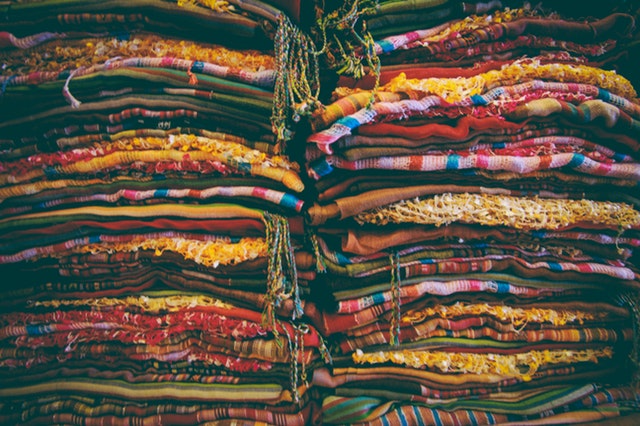In the southern mountain regions, the main beast of burden to replace the camels of the desert is the llama, and its cousin the alpaca. Llamas tend to be larger and stronger than the alpaca, which provides finer wool. Both are sure-footed animals and survive well in the sparse vegetation and minimal water of the dry mountain foothills. These animals live in small herds where the lead female is marked by a collar adorned with bells. Llama and alpaca are also used for milk, meat and hides.
The coats are brushed and sheared once a year in spring and the rest of the year is taken carding, spinning, dyeing and weaving the textiles that the mountain dwellers wear and trade. The fabric is often plain, solid colours for local use, using ochres and plants to dye the wool soft yellows and blues. The trade textiles are vividly patterned in geometric designs, using many more colours such as green, black and red.
Llama and alpaca wool textiles are not expensive to buy but are a great asset to those who live and work in colder regions, or who travel the desert by night.
Properties
Llama wool textiles are hard-wearing and tightly woven into fairly fine cloth that felts when washed. Alpaca wool is more often knitted or crocheted into small clothes, hats and mittens, and is particularly popular for baby clothing, as it is very fine and soft.
The wool has natural waterproof properties due to the oils in its raw state. If these are washed out, and the textile is dyed, then it can be treated with oil to restore that quality. Otherwise, the fabrics last a few years before they fray, tear or fade, dependent upon the amount of use and wear they get from the owner. It is known that some rugs commissioned for the Viziers of the main cities of Zami Ramal are over 100 years old and very well preserved.
Llamas and alpacas live only in the southern foothills and mountains of Zami Ramal, where they roam as free herds.
History & Usage
Resourceful tribespeople always used every part of their herd animals and the llama and alpaca are no exception. Ever since they were domesticated, the wool has been either brushed out or sheared and used for textiles, fastenings and decoration.
The human tribes that live in the southern foothills and mountains use the woollen textiles for their everyday clothing and furnishings.
A special blanket is woven from alpaca wool to celebrate the birth of a new child so that everyone has their birth blanket to keep for their lifetime. The designs represent their family and differ between villages and herdsmen.
The raw fleece from llamas and alpacas is usually washed and dyed as soon as it is sheared. In some cases, the fleece is allowed to remain raw to retain the oily component and the natural colour. It must then be carded between combs to ensure all fibres lay in the same direction. The fibres are then spun together on a wheel, producing a strand of varying thickness, depending upon its final use. The yarns are then woven into fabric, crocheted or knitted into the required items, such as rugs, coats, shirts, hats or mittens.
Distribution
The woollen textiles are sold by the merchants of the south. Usually, one or two agents will collect the completed items to be sold and take them by camel train to the cities to trade for whatever is needed by the sellers.









Comments